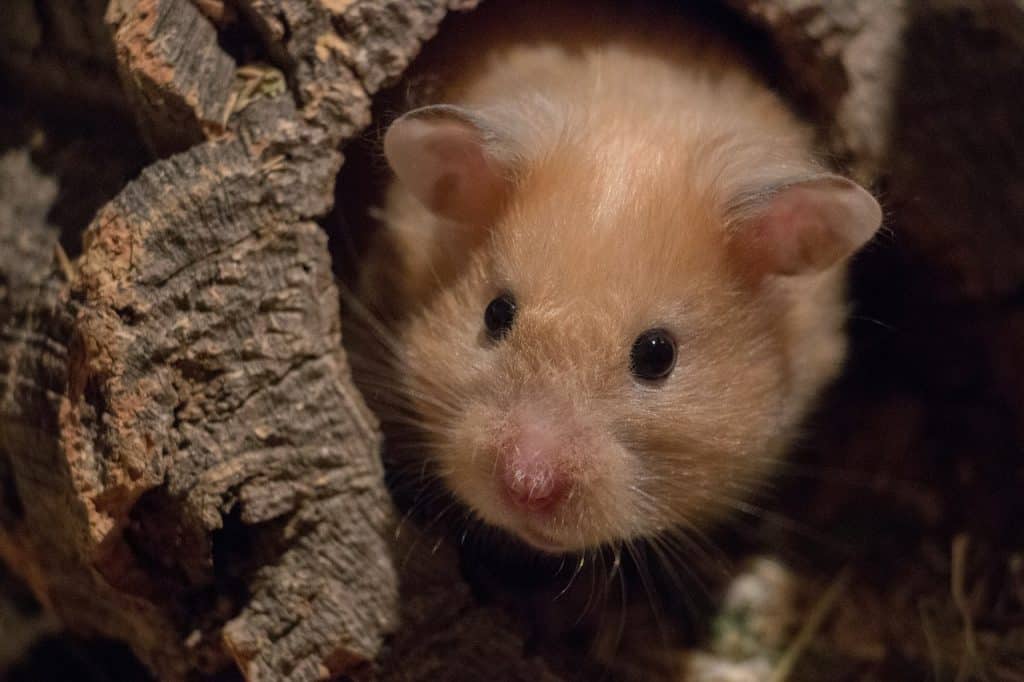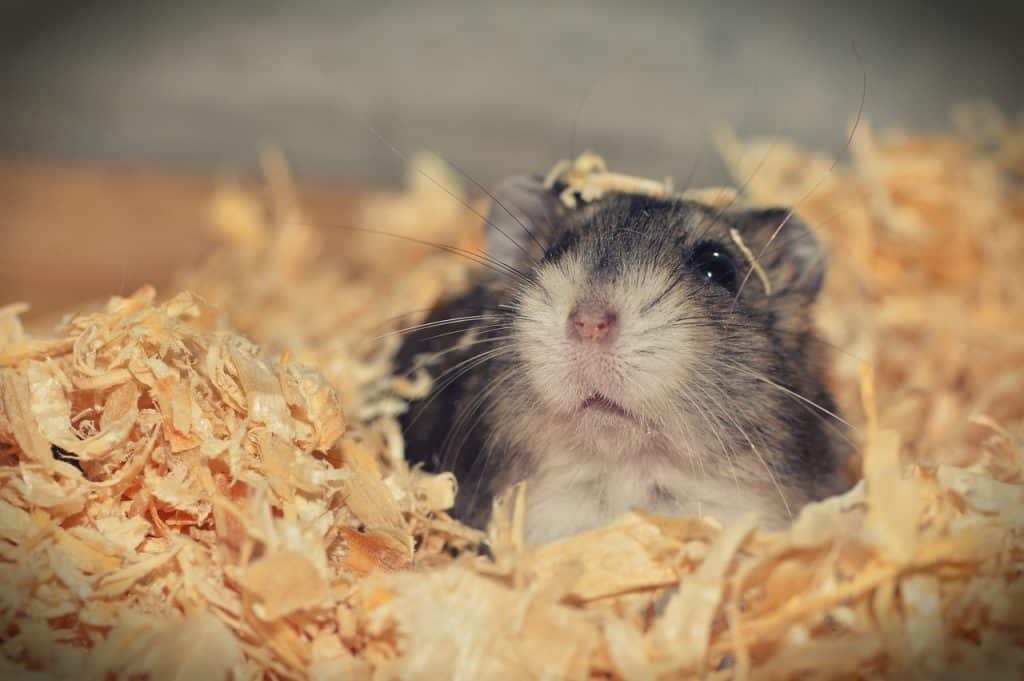
Hamsters are one of the cutest creatures on earth. Hamsters have the cutest little furry faces, with puffy cheeks and adorable facial expressions.
They come in so many colors, there is a hamster for everyone!
We’ll first look at the top colors for hamster coats. Then we will show you the hamster patterns that can be used to help you choose your next hamster.
These are the 14 most common colors for hamsters:
Hamsters don’t have to be covered head to toe with one color. Although they will primarily display one color, there might be patterns or splotches in other colors. These may seem like dominant colorways for your genes, but they are not.
1. Golden Hamster

This is the dominant color of hamsters. This is also the most common hamster color found in nature. Goldens will have golden brown fur and black cheek markings. The undercoat is usually grey with an ivory belly and grey ears. This is the dominant colorway of hamsters. If you don’t mate two hamsters with recessive genes, or a particular combination, you will always get golden hamsters.
2. Beige Hamster

Beige hamsters can be rarer than goldens and are therefore lighter in color. This is because beige hamsters are only created by crossing a rust-colored and a dark grey genetic hamster. Both these parent colors are recessive and very rare. Beige hamsters can be the runts in their litter and may have a kinked or wavy tail.
3. Brown Hamster

Light brown hamsters have a distinct brown color and very few spots of lighter fur if any. This color is due to two recessive brown parents. They still have pinkish feet and feet, making them one adorable hamster.
4. Black Hamster

The recessive color black tends to become dark brown (chocolate), as they age. A common belief among pet shops is that black hamsters are more gentle than other hamsters. This is a myth. Black hamsters are just as crazy as any other color.
5. Blonde Hamster

This hamster has a cream-colored, light-tan coat and ivory-colored bellies. Their back fur is usually light grey with cinnamon coloring. The standard blonde is actually crossbred from a cinnamon parent and a light-grey one. Blonde hamsters might have red eyes.
6. Chocolate Hamster
These furballs are dark brown all around but may have streaks or rusty cinnamon colors. They are still able to show off their pin feet and hands, just like the brown variety.
7. Cream Hamster

Cream might seem to be a simple color. Its appearance is similar to a light coffee roast with just a little milk. It is genetically very special. It is a recessive genetic, but it will still dominate over the recessive black gene. This will hide the parentage from the black hamster parent.
8. Dove Hamster
This color is very rare as it requires a different parentage. Dove-colored hamsters were born to cinnamon and black parents. A dove hamster, as shown in Punnett squares and paper, is the red-eyed black version of the hamster. The cinnamon gene makes the hamster appear to be a light grayish color.
9. Grey Hamster
There are many shades of grey hamsters, from light to dark to silvery to deep. These colors are unique because they dominate all other colors, except for golden. The light grey gene can prove fatal as 25% of the pups born to light grey mothers die in their uterus.
10. Lilac Hamster
These hamsters can be very beautiful and highly sought after. Their coat is light grey with pinkish-colored spots. Lilac hamsters can only be obtained by crossing a cinnamon gene and a dark grey gene. Lilac hamsters have a tendency to brown as they age, creating a unique coat.
11. Sable Hamster
The sable hamsters are unique in their appearance, although it may be hard to pinpoint exactly what it is. Their undercoat is different from their outer coat. Their outer layer is either brown or chocolatey and their undercoat is cream. The cream coat can be seen around the eyes, creating eye-rings.
12. Mink Hamster
These hamsters can be described as the red-eyed variety in sable hamsters. These hamsters often have a cinnamon or rust color. However, they still have the same cream undercoat that shows through–particularly around the eyes.
13. Rust Hamster

One of the newest colors for hamsters is rust color. It was first discovered in 1960 in England. The color was first described as a mutation of brown or cinnamon. The rust mutation, unlike most mutations, allows the hamster not to lose its red eyes but keeps them black.
14. White Hamster
This color scheme can make it difficult for hamsters to find, as there are many genetic combinations that also produce deformities. There are three types of white hamsters: flesh-eared (dark-eared), and black-eyed (black-eyed). Both the flesh-eared and darker-eared varieties both have red eyes. They have different colored ears. The black-eyed white hamsters are born with dark eyes and flesh-colored ears.
6 Ornate Hamster Designs
Hamsters can have many different coat designs on their coats, some of which are classified as their own.
15. Pattern for Banded Hamster
The horizontal band that runs from their belly to belly is the typical feature of banded hamsters. This band is usually white, but other colors like cream have been observed.
16. Dominant Spot Hamster Pattern
Dominant spot patterns are a dominant trait. These hamsters are ideally white, but other colors are also possible. They can have colored spots or a body with lighter colors. These spots can range in color and may extend to the ears. Due to the 25% risk of death in the womb, it is best to not mate with two dominant spot gene hamsters.
17. Tortoiseshell Hamster Pattern
This pattern is only found on female hamsters, as tortoiseshell patterns can be gender-linked. This pattern is composed of yellow spots that are all over the base color of the hamster. Tortoiseshell patterning can be seen on all colors of hamsters, except cream which will hide the spots.
18. Roan Hamster Design
Roan hamsters are only found in cream-based colors. This is when the base color is mixed with white fur, so the hamster’s hair is darker than the rest. This is a dominant genetic trait, so you should be careful when breeding them. Two roan hamsters can be bred together to produce eyeless white babies or stillborn young.
19. Recessive Dappled Hamster Pattern
This is a recessive trait that makes the hamster white except for its head, rear, and rear. They can choose any color they like. Brown is the most popular.
20. Cinnamon Hamster Recipe
Cinnamon hamsters have the most basic red-eyed color. They are also the foundation of many other colors and patterns. Their rich orange color is masked by their gray undercoat and light-colored ears.
Hamster coats in a variety of colors
There are many different colors your hamster could choose from, as you can see. They can be loved equally regardless of whether they have different coats.
What are the most uncommon hamster colors?
Beige is a rare color because it is produced by breeding a hamster with rust and dark grey genes, both of which are uncommon. Due to the Dark Grey gene, the beige variety is often smaller than the rest of the litter and may have a kinked tail. Beige Genotype Variation badging
So, what color is best for night lights?
The answer will astound you! RED! When hamsters were exposed to red light at night, they showed significantly less evidence of depressive-like symptoms and brain changes associated with depression than those exposed to blue or white light.
Do hamsters require constant attention?
Even though hamsters are small, they require a significant time commitment. They, like other animal companions, require daily care, exercise, and attention.
Do hamsters enjoy being kissed?
Hamsters enjoy the affection of the human with whom they have formed a bond. They actually thrive on it. While you can’t kiss your hamster, you can show him affection.
What causes my hamster to ‘freeze’?
Fear or surprise will cause a hamster to ‘freeze’ temporarily. Because their eyesight is poor, they must listen and sniff to figure out what is going on. You can make your hamster’s environment less stressful.
Do hamsters remember their owners?
Given enough bonding time, a hamster can get to know his or her owner over time. Your hamster will begin to recognize you with the proper amount of socialization. They’ll even start to bond with you after a while. However, hamsters rarely bond with more than one or two people in their lives.
Is a hamster aware of its own name?
They enjoy playing, exercising, and exploring once they’ve gotten used to you and your new surroundings. Once trained, your dwarf hamster is even capable of recognizing and responding to its own name.
What do hamsters enjoy playing with?
Hamsters enjoy chewing on things, so providing a non-toxic chew toy is always a good idea. Wooden toys are a good choice if the wood is pesticide/chemical free (not pressure-treated or painted). Because of the aromatic oils in cedar and evergreen tree wood, which can cause respiratory irritation, avoid using it.
Can hamsters consume grapes?
Yes, but only in moderation or as an occasional treat due to their high sugar content.
What are the most common hamster colors?
Syrian hamsters have been bred in a wide range of colors, including Beige, Black, Blonde, Brown, Chocolate, Cream, Dove, Golden, Grey, Lilac, Mink, Sable, Tan, and White.